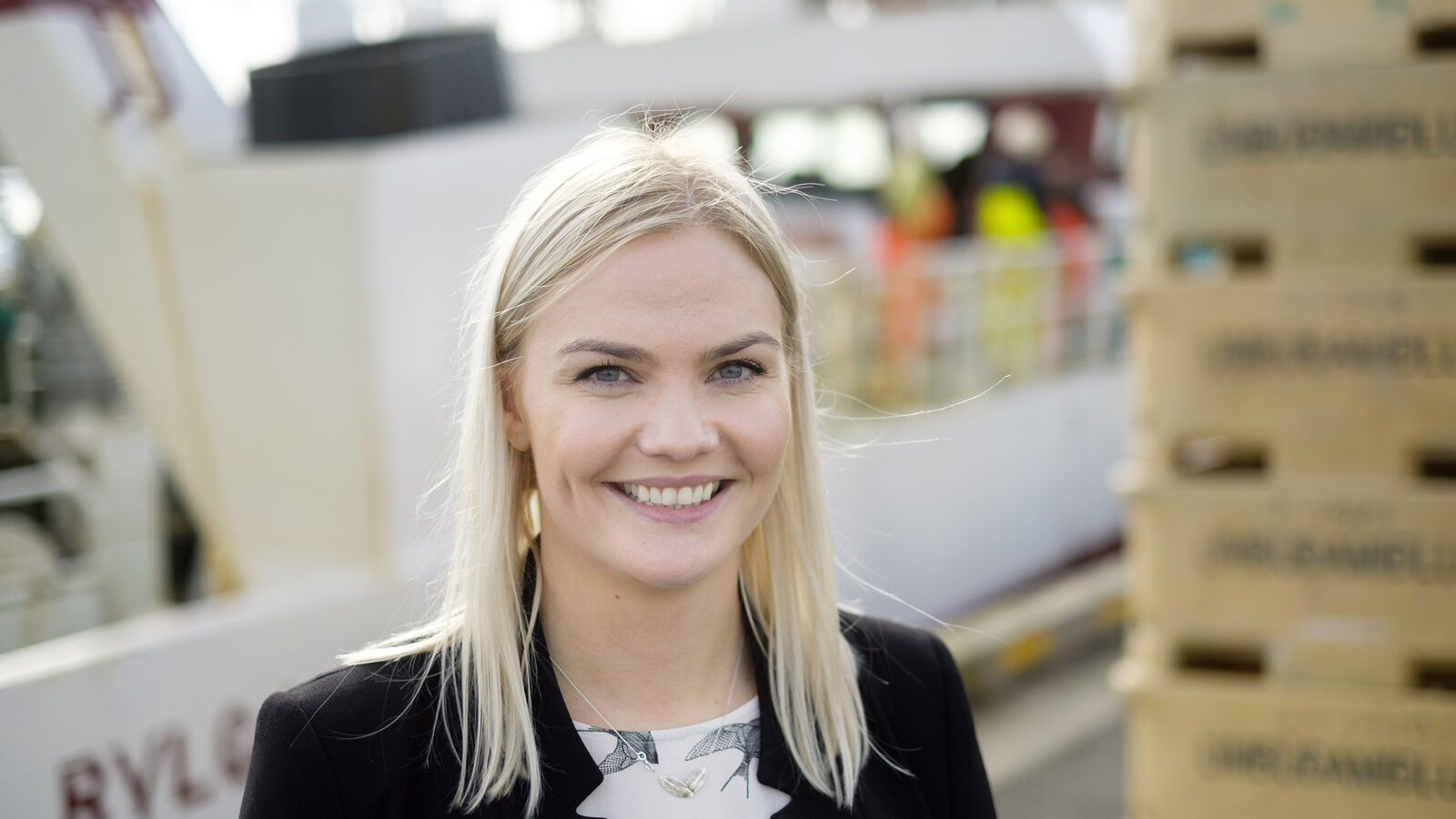Funded research projects
For graduate students at RU
Every spring, graduate students at RU can apply for funded research projects. The projects are funded by dynamic Icelandic companies such as Eimskip, Isavia, Marel, Siminn, Icelandair, Islandsbanki and Fisheries Iceland. By completing the projects, students create knowledge and gain valuable industry experience.
For graduate students at RU
Every spring, graduate students at RU can apply for funded research projects. The projects are funded by dynamic Icelandic companies such as Isavia, Marel, Siminn, Icelandair, Islandsbanki and Fisheries Iceland. By completing the projects, students create knowledge and gain valuable industry experience.
An information session is held in RU each year where representatives from the companies introduce research opportunities in their field. Graduate students are encouraged to attend. Project ideas for the school year 2020-2021 were presented on a meeting on March 10. Below you can access the company's presentations. Application deadline is April 10.
The process
Students that wish to work on a certain research project must have a project supervisor who applies on their behalf. Project supervisors within every academic department can submit applications. A joint steering committee from the company and RU will decide what projects will receive funding.
Examples of projects
RU graduate students have researched cognitive workload in aviation by monitoring speech, done a construction plan of a new runway, studied churn prediction and customer segmentation using data mining and machine learning methods, and biodiversity beyond national jurisdiction from an Icelandic perspective.
Further information:
Information about the collaboration with each partner, including deadlines and the relevant application documents, are accessible below. Further information is given by Margrét H. Þóroddsdóttir, Industry Relations project manager: margretth@ru.is
Partners
Icelandair
Icelandair Group and Reykjavik University have made a collaboration agreement about entrepreneurship, innovation, research and education in the fields of airline services and tourism.
Icelandair – RU Joint Steering Committee
- Páll Melsted Ríkharðsson, Dean of RU School of Business
- Guðrún Sævarsdóttir, Dean of RU School of Science and Engineering
- Magnús Þ. Lúðvíksson , Business Development, Icelandair Group
- Bragi Baldursson, Head of Design at Icelandair
Joint Steering Committee Liaison:
- Margrét H. Þóroddsdóttir, Industry Relations, margretth@ru.is
Isavia
Isavia and RU have made a collaboration agreement about research on air traffic, especially air navigation and airport operations.
Isavia – RU Joint Steering Committee:
- Guðrún Sævarsdóttir, Dean of RU School of Science and Engineering
- Yngvi Björnsson, Dean of RU School of Computer Science
- Hjalti Pálsson, Manager Research & Development ANS
- Sigurdur Olafsson, Director Human Resources Isavia
Joint Steering Committee Liaison:
- Margrét H. Þóroddsdóttir, Industry Relations, margretth@ru.is
Marel
Marel is a leading global high-tech company at the forefront of developing and manufacturing advanced processing systems and services, software and solutions for the food industry.
The aim of the agreement is to promote research and development in the fields of production of processing systems, software and solutions for the food industry, as well as focusing on human resource management and continuous improvement.
Joint Steering Committee Liaison:
- Margrét H. Þóroddsdóttir, Industry Relations, margretth@ru.is
Fisheries Iceland
Fisheries Iceland and RU have signed an agreement of co-operation to strengthen research and innovation in the Icelandic fishing industry, with the aim of increasing sustainability, improve the utilization of products and increase the number of jobs in the industry.
Fisheries Iceland – RU Joint Steering Committee:
- Páll Melsted Ríkharðsson Dean of RU School of Business
- Páll Jensson, Professor, School of Science and Engineering
- Brynjólfur Eyjólfsson, Marketing Manager at HB Grandi
- Heiðrún Lind Marteinsdóttir, Managing Director at Fisheries Iceland
Joint Steering Committee Liaison:
- Margrét H. Þóroddsdóttir, Industry Relations, margretth@ru.is
Ph.D Student Grants from RU Research Fund
RU Research Fund has awarded 10 new Ph.D. Student Grants. The total amount awarded to new projects is 57.480.000 ISK. The Fund received 19 new applications. Below are informaton on new projects receiving grants from the Fund 2021. Each grant is 454.000 ISK per month (salaries) for one year + max 300.000 ISK travel grant.
Besides new projects funded 2021, 5 projects will receive continious grant (2nd or 3d year). The total amount granted to continious projects is 28.740.000 ISK, hence the total amount allocated 2021 is 86.220.000 ISK.
Grants to new project 2021
- Applicant: Kristinn Torfason
Department: Dept. of Engineering
Doctoral Student: NN
Supervisor: Kristinn Torfason, Ágúst Valfells og/and Andrei Manolescu
Project title: Properties of Electron Beams from Microstructured Emitters
Short description of the project: The project's ultimate goals are to advance scientific understanding of fundamental processes in microand nanoscale vacuum electronic devices and to further develop a computer code we have written for simulation of such devices. We also aim to build competence in the field of vacuum electronic and computational physics in Iceland. The code uses molecular dynamics simulations to investigate the properties of photo, field, and thermionic emission in vacuum electronics. The proposed additions to the code in this project are ion enhanced field emission, sidewall emission from carbon nanotube fibers, emission from grain boundaries, and cathode heating effects. - Applicant: Paolo Gargiulo
Department: Dept. of Engineering
Doctoral Student: Deborah Cecelia Rose Jacob
Supervisor: Paolo Gargiulo
Project title: Quantifying postural control and motion sickness assessing biosignals during virtual reality simulation
Short description of the project: This grant application covers research on postural control (PC) and motion sickness (MS), focussing on seasickness as it is the best known manifestation of MS, at least among Icelanders. The research project is based on new methodologies that: 1.Use the latest technology that integrates visual- and support moving systems based on virtual reality, called a motion sickness simulator. 2. Sample a number of biosignals, that indicate that an individual is affected by MS (induced by the MS simulator), including EEG, EMG and posturography. 3. Coordinate the stimulation/effect of the MS simulator with sampled biosignals of those tested at any time and processes the data with the help of machine learning.
Through the use of these technologies we aim:
• To better explain the system of PC.
• To explore and propose new ideas regarding causes of motion sickness.
• To develop and standardize “best fit” function regarding the visual- and support movements of the MS simulator, i.e. the type/character and the volume/intensity (input) that develops the most characteristic markers to be identified by the selected biosignals (output).
This study will allow the development of several applications such as treatment of MS/seasickness to improve the well-being of those working in a moving environment as experienced at sea and at the same time increase their safety. - Applicant: Leonard Matthias Eberding
Department: Dept. of Computer Science
Doctoral Student: Leonard Matthias Eberding
Supervisor: Kristinn R. Þórisson
Project title: Autonomous Context-Based Perception in AI Architectures
Short description of the project: A basis for any intelligence is the observation of the environment. However, a major problem in machine learning algorithms designed to be deployed in the real world is the extremely high number of statespace variables. Current approaches built on Markov-Decision-Processes and Markov-Models for policyor value-calculation do not support such highly complex environments. The huge dimensionality leads to an infeasibility of state-action mapping calculations. Therefore a system is needed which can constrain the state- and therefore search-spaces of AI systems.
To tackle this issue we propose a theory of context-based perception – the ability to extract contextualized high-level associations of raw sensory data. By introducing hypergraph theory into nonaxiomatic model-based AI architectures a system is created, which is able to group knowledge in dynamically calculated hypergraph edges. Thus making it possible to extract relevant data dependent on the current situation (task and environment) and use this relevance to constrain observations. A mathematical formalization of hypergraph based context creation, the possibilities to constrain search spaces, and a programmed implementation of such a perception apparatus is planned in this project.
As shown in this proposal, introducing contextual perception into AI systems shows a promising route towards maintainable, fair, sustainable, and economic AI architecture. - Applicant: Marta Serwatko
Department: Dept. of Engineering
Doctoral Student: Marta Serwatko
Supervisor: Erna Sif Arnardóttir and Jón Guðnason
Project title: Development of new analysis techniques for sleep disordered breathing in adults and children
Short description of the project: The traditional measurement of obstructive sleep apnoea (OSA) severity, the counting of respiratory events using the apnoea-hypopnea index (AHI) per hour sleep is outdated. AHI reflects only in a limited manner the degree of sleep disordered breathing (SDB), a spectrum from habitual snoring to severe OSA. This is found for all age ranges and is especially poor when assessing children. The main objective of this study is to develop better diagnostic tools to assess SDB severity, in both adults and children. In this project, we aim to better understand the physiological consequences of SDB at different levels, by comparing various biological signals, measured both invasively and noninvasively. Another aim is to assess the role of new obstructive breathing indices as diagnostic tools and the effects they have on sleep stability and daytime performance (neurocognitive tests, questionnaires and standardized school grades) compared to AHI. The study involves two cohorts; Esophageal pressure (Pes) measurement cohort (31 adult participants) and Paediatric sleep study (116 participants, children born in the years 2005-2010). The range in SDB level in both groups is high, from normal breathing to severe OSA. The measurements among adult subjects included a simultaneous Pes manometry and polysomnography. Information about the paediatric participants included their measures from neurocognitive tests, questionnaires, standardized school grades and a polysomnography. - Applicant: Maxime Elliott Tullio Segal
Department: Dept. of Engineering
Doctoral Student: Maxime Elliott Tullio Segal
Supervisor: Sverrir Ólafsson and Heiðar Ingvi Eyjólfsson
Project title: Hönnun fjárhlutfallskveikja fyrir skilgreind breytanleg skuldabréf / Designing Capital Ratio Triggers for Contingent Convertibles
Short description of the project: Contingent Convertibles (CoCos) are relatively recently developed debt financial instruments. Their main purpose is to provide the issuing entity with enhanced financial stability by maintaining capital and/or leverage ratios on the right side of some prefixed values. These ratios are maintained by converting part of the bond principal into equity when the required capital ratios are breached. The CoCos aim to recapitalize the bank, before it is on the brink of collapse to avoid state bailout at a huge cost to the taxpayer.
The focus of this research work is to develop a comprehensive mathematical model for the pricing of these instruments and design conversion triggers that maintain adequate market ratios for the bank to continue its operations. Under normal circumstances, CoCo bonds function as ordinary coupon paying bonds, which only in case of insufficient capital ratios are converted into equity of the issuer. The key in the proposed work is related to the automatic conversion and does not require the judgement of regulatory authorities.
The pricing of the proposed instruments is difficult as the conversion is dynamic. We view CoCos essentially as a portfolio of different financial instruments. This treatment makes it easier to analyse their response to different market events that may or may not trigger their conversion to equity. The resulting model will be calibrated on real market data to help the issuing institution to construct more efficient hedging strategies. - Applicant: Hákon Örn Árnason
Department: Dept. of Engineering
Doctoral Student: Hákon Örn Árnason
Supervisor: Ágúst Valfells and Halldór Guðfinnur Svavarsson
Project title: Fabrication of microdiode for THz current generation
Short description of the project: This project is a one year extension of a research project concerning fabrication of a vacuum microdiode for generation of THz frequency modulated current. The space-charge modulated current requires a robust photocathode with discrete emitting areas. This work concerns selection and testing of cathode materials, specifically GaAs based photoemitters and pure metallic photoemitters. Characteristics of photoemission from GaAs based photocathodes will be measured for different surface treatments. Similarly, characteristics of photoemission from metal cathodes and limits set by ablation will be studied. The project will result in fabrication of a vacuum microdiode and measurement of I-V characteristics under photoemission. - Applicant: Zelly Rose Atlan
Department: Dept. of Psychology
Doctoral Student: Zelly Rose Atlan
Supervisor: Rannveig S. Sigurvinsdóttir
Project title: Sexual Minority Stress Theory in an Icelandic Context
Short description of the project: The relationship between sexual minority identity, internalizing pathologies - depressive symptoms and perceived stress - and externalizing behaviors - substance abuse, self-harm, and suicidality - will be assessed (year 1 of the study). We will control for both the risk factors of sexual abuse and physical and online victimization, as well as the protective factors of social and familial support and spirituality. We hypothesize, in line with prior research, that sexual minority youths (SMY) will have higher rates of internalizing pathologies and externalizing behaviors than their heterosexual peers. We also hypothesize that these health disparities will remain after controlling for the risk and protective factors. The next two years will be spent on a pilot study aiming to validate sexual minority stress theory for the first time in an Icelandic context. Sexual minority stress theory posits that members of minority groups endure chronic stressors specific to that minority identity, resulting in higher rates of negative life outcomes. We will formulate and distribute a survey documenting these unexplored factors. It is hypothesized that there will be unique factors of sexual minority stress that will explain the poor mental health and destructive behaviors being experienced at a higher rate by SMY. It is with these results that psychologists and public policymakers can work toward designing effective prevention and intervention programs to diminish these health disparities. - Applicant: Ingunn S. Unnsteinsdóttur Kristensen
Department: Dept. of Psychology
Doctoral Student: Ingunn S. Unnsteinsdóttur Kristensen
Supervisor: María Kristín Jónsdóttir, Hafrún Kristjánsdóttir and Helga Ágústa Sigurjónsdóttir
Project title: Concussions Among Icelandic Athletes: A multi-component study
Short description of the project: Concussion history has been connected to mental health problems, cognitive impairment, and executive dysfunction. Millions of sport-related concussions occur every year with no concrete way to confirm a concussion physically. However, virtual reality, in conjunction with electroencephalography(EEG) show promise. Hypopituitarism(HP) has been connected to head trauma so changes in hormonal values may also indicate a problem in relation to concussion symptoms. Males are more frequently the subjects in concussion research which is a concern as women are more likely to be injured and suffer from worse consequences. Concussions are probably underdiagnosed in Iceland as elsewhere in the world. Recent studies are limited and there is a lack of knowledge about the scope of SRC incidence in Iceland.
The aims of this project are threefold: 1/To evaluate concussion incidence among Icelandic males and females over 24 months. Participants will be at an elite level in football, handball, basketball, and ice hockey. A follow-up will be made and symptom progression will be monitored. 2/ To examine the relationship between hormonal changes and post-concussive symptoms among Icelandic female elite athletes. 3/To examine the relationship between EEG activity measured in virtual reality and concussion history among Icelandic female elite athletes.
This project offers a unique opportunity to study complex clinical profiles in an underrepresented group which will beneficial in clinical settings. - Applicant: Björn Jón Bragason
Department: Dept. of Law
Doctoral Student: Björn Jón Bragason
Supervisor: Ragnhildur Helgadóttir and Ragnheiður Kristjánsdóttir
Project title: The Office of the Head of State in Iceland from the founding of The Kingdom of Iceland in 1918 until present days
Short description of the project: The main research question of this project is: What is the current role of the President of the Republic of Iceland in light of the historical and legal origins of his office? No extensive legal and historical comparative study of the role and status of the President of Iceland has yet been conducted. A well-crafted and thorough study of the topic will hopefully be valuable input into the debate through international and historical comparisons, as well as a new viewpoint on the issue. Based on an extensive exploration of a wide range of primary sources, this study therefore offers to break new ground. In order to understand the current office of the President of Iceland, it is vital to examine its origin in the creation of the office of King of Iceland as a head of state in 1918. - Applicant: Illugi Torfason Hjaltalín
Department: Dept. of Business Administration
Doctoral Student: Illugi Torfason Hjaltalín
Supervisor: Hallur Þór Sigurðaron
Project title: Artificial Intelligence in the 21st Century: Developing, Implementing and Deploying AI in Iceland's Public Sector
Short description of the project: For the past decade, artificial intelligence (AI) has been receiving increased attention from academics and practitioners alike. Countries have identified opportunities associated with the development and use of AI and many have defined national AI strategies. While the technical aspects of AI applications have been extensively studied by researchers, the challenges of implementing and applying AI has been absent from the literature. The current PhD research aims to fill this gap by studying the challenges of implementing AI for government agencies in Iceland. Furthermore, to investigate the role of policymakers and how a national AI strategy can facilitate the development and use of AI in the public sector. Qualitative and quantitative approaches will be applied to collect data from public agencies who are using or intend to use AI. The study‘s findings could have value for practitioners and academics, as an input for defining AI strategy and impetus for future research, respectively.
Continious grants 2021
| Applicant | Project title | Department | Doctoral student |
|---|---|---|---|
| Arash Sheikhlar | Causal knowledge transfer via Non-Axiomatic Reasoning | Dept. of Computer Science | Arash Sheikhlar |
| Émile Nadeau | Extending the Combex framework | Dept. of Computer Science | Émile Nadeau |
| Halldór Guðfinnur Svavarsson | Piezoresistance of silicon-nanowire arrays | Dept. of Engineering | Elham Aghabalaei Fakhri |
| Hlín Kristbergsdóttir | Psychosocial risk factors for childbirth interventions and neonatal outcomes | Dept. of Psychology | Hlín Kristbergsdóttir |
| Sigurður Ingi Erlingsson | Analytical results for Shubnikov-de Haas oscillations in a two-dimensonal electron gas with spin-orbit and Zeeman coupling | Dept. of Engineering | Hamed Gramizedeh |


